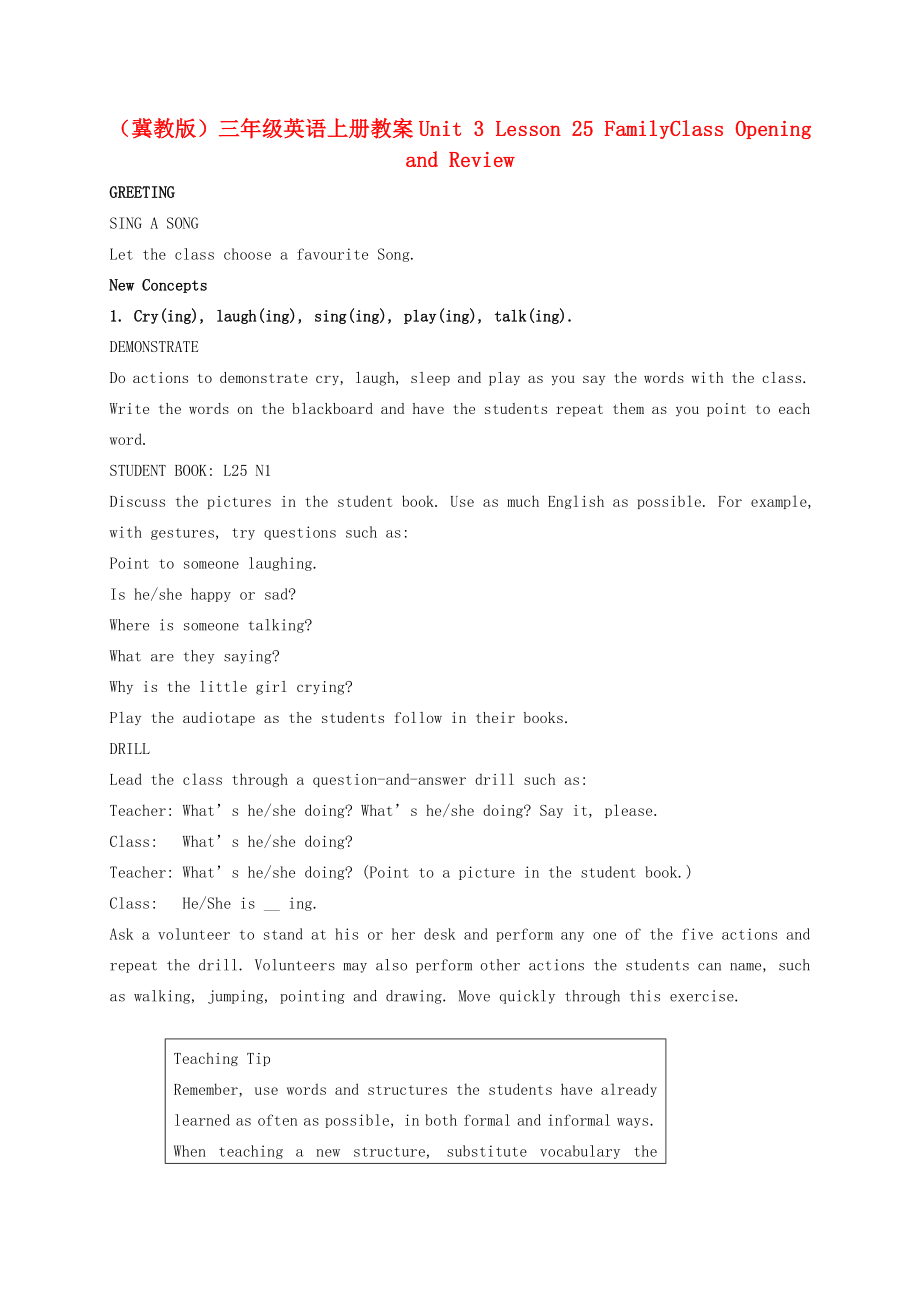《三年級英語上冊 Unit 3 Lesson 25FamilyClass Opening and Review教案 冀教版》由會員分享��,可在線閱讀�����,更多相關(guān)《三年級英語上冊 Unit 3 Lesson 25FamilyClass Opening and Review教案 冀教版(3頁珍藏版)》請在裝配圖網(wǎng)上搜索����。
1、此資料由網(wǎng)絡(luò)收集而來���,如有侵權(quán)請告知上傳者立即刪除�。資料共分享,我們負責傳遞知識�����。
(冀教版)三年級英語上冊教案Unit 3 Lesson 25 FamilyClass Opening and Review
GREETING
SING A SONG
Let the class choose a favourite Song.
New Concepts
1. Cry(ing), laugh(ing), sing(ing), play(ing), talk(ing).
DEMONSTRATE
Do actions to demonstrate cry, laugh, sleep a
2���、nd play as you say the words with the class. Write the words on the blackboard and have the students repeat them as you point to each word.
STUDENT BOOK: L25 N1
Discuss the pictures in the student book. Use as much English as possible. For example, with gestures, try questions such as:
Point to s
3����、omeone laughing.
Is he/she happy or sad?
Where is someone talking?
What are they saying?
Why is the little girl crying?
Play the audiotape as the students follow in their books.
DRILL
Lead the class through a question-and-answer drill such as:
Teacher: What’s he/she doing? What’s he/she doin
4���、g? Say it, please.
Class: What’s he/she doing?
Teacher: What’s he/she doing? (Point to a picture in the student book.)
Class: He/She is __ ing.
Ask a volunteer to stand at his or her desk and perform any one of the five actions and repeat the drill. Volunteers may also perform other actions
5����、the students can name, such as walking, jumping, pointing and drawing. Move quickly through this exercise.
Teaching Tip
Remember, use words and structures the students have already learned as often as possible, in both formal and informal ways. When teaching a new structure, substitute vocabular
6����、y the students have already learned. Find natural opportunities to make conversation with individual students in English, such as asking questions, making requests and giving assistance.
ACTIVITY BOOK: L25 N1
This exercise requires the students to underline laugh, cry, sing or, play to matc
7、h pictures.
2. Family, daughter, son, mother, father.
STUDENT BOOK: L25 N2.3
Explain that the class will learn about families.
Lead the class in a discussion about the pictures in the student book of Jenny’s family and Li Ming’s family. For example, ask the students what they notice about the o
8��、rganization of the pictures. Why are the pictures organized that way? Make statements about the pictures that review the vocabulary and link the concepts of boy/man with son/father, and girl/woman with daughter/mother.
For example:
He/She is a boy/girl. He/She is a son/daughter.
Son/Daughter. Say
9�、 it, please.
Where is Jenny? This is Jenny’s family.
(Circle Jenny’s family.)
This is Jenny’s father/mother.
He/She is a man/woman.
Father/Mother.
This is Li Ming’s father. He is a man.
He is a father. Father.
Play the audiotape as the students follow in their books.
DRILL
Lead the class i
10���、n a drill about family members. For example, draw a rough picture of a family on the blackboard. Point to people in the picture and ask questions such as:
Teacher: Is this a _____or a ____?
Class: A ____.
Teacher: Is he a daughter?
Class: No, he’s a son/father.
Remember to call on individua
11��、l students sometimes and sometimes groups of students or the whole class. As the students reply, write the word on the blackboard with an arrow drawn to the correct person.
ACTIVITY BOOK: L25 N2.3
In Number 2, the students match words for family members with pictures by writing the correct letter
12��、 in each circle.
In Number 3, the students draw a picture of their own family and label the people in it with the new family vocabulary. Show the students the word list at the bottom of the exercise. Some of the students may want to add more people than they can label in English. This would provide you with a natural opportunity to supplement their vocabulary with words such as aunt, uncle, cousin, niece and nephew.
Class Closing
SING “IF YOU’RE HAPPY AND YOU KNOW IT”
Do the song with a variation. Ask half the class only to sing and the other half only to do the actions.
 三年級英語上冊 Unit 3 Lesson 25FamilyClass Opening and Review教案 冀教版
三年級英語上冊 Unit 3 Lesson 25FamilyClass Opening and Review教案 冀教版

